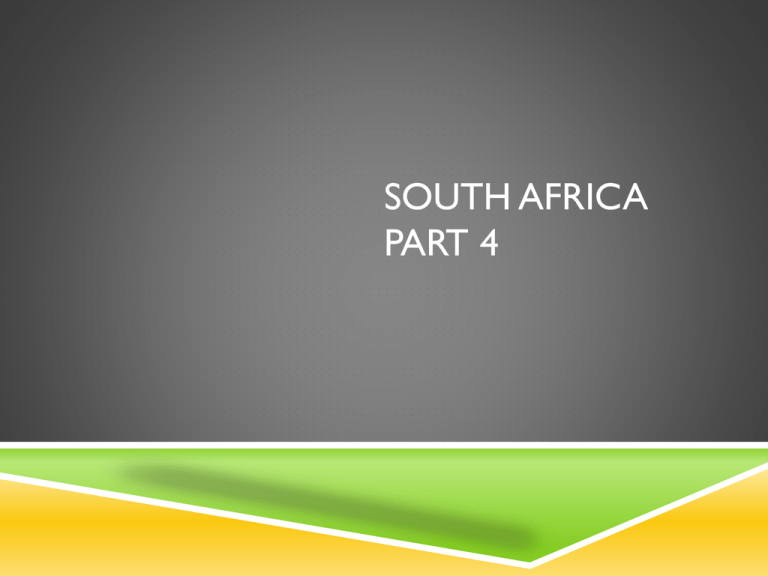South Africa Part 4
advertisement

SOUTH AFRICA PART 4 BELLWORK: DEFINE TERMS Creolization: As a result of colonization there was a mixture between people of indigenous, African, and European descent. Sharpeville Massacre: 60 black Africans murdered while protesting Apartheid legislation. Portamento glides: when the vocalist falls or slides to the lower pitch on sustained tones. Re-africanization: to give control of the government back to the Africans; to re- establish African culture. ANNOUNCEMENTS Test on South Africa Tuesday May 6th. Reading Outline #23 due this Thursday, May 1st. OUTCOMES Scholars Will: Grammar: Learn basic facts about South African music Logic: Learn how to gumboot dance SHARPEVILLE MASSACRE GUIDED NOTES The growth of the economy just before the apartheid increased communication between ethnic groups African music is social. All performers submit to the invisible conductor of the collective. King Kong: the first African Musical with black south African performers, musicians and narrative 1950’s South Africans are one of the first countries in the world to run a successful multicultural democrary HOW DANCE AND MELODY SHAPE ARE RELATED Leading tone “lifts the melody back onto the tone center.” This corresponds to concepts of dissonance and resolution. This melodic movement corresponds with the raising, dipping and turning the body. During a dissonant note—a leading tone, the body may turn or dip. When returning to the tonic, or resolving the chord, the body may be raised. ACTIVE LISTENING #5 AFRICA Name all the instruments you hear in this track. In which genre would you classify this song? What makes this song sound South African? JUST THE FACTS #5 AFRICA This song represents the brotherhood many South Africans feel for African-Americans and their struggles against racial oppression. This song is a perfect example of Capetown Jazz. This song speaks of a longing for Africa and a vision for a new nation. It is prophetic in nature, for when this song was written in the 1980’s there was little hope for change or a bright future. The vocalist is Sathima Bea Benjamin CFU: LEARN GUMBOOT DANCE INSTRUCTIONAL VIDEOS STEP #1 Hit 1 2 3 4 Then do that 3 times Hit your knee with your right hand, step first with your right foot. Note: Hits are very quick. STEP #2 Hit both hands on each thigh, then stamp Hit stamp Hit stamp 3 4 Do this step 3 times STEP #3 Turn to your right in a circle: “I fly” Hit Right Left Hit right left hit right clap left Then turn the other way Hit right left Hit right left hit right clap left CHARACTERISTICS OF SOUTH AFRICAN MUSICAL LANGUAGE: NAME THREE Non-verbal utterances Tonal Language Words articulate life experience COMMON BELIEFS OF THE ZULU AND TSWANA PEOPLES A belief in: the continuing existence between the living and the dead Healing Prophecy ZULU PHILOSOPHY “Man can only become fully human through his relationships with his fellow men” NAME THREE Characteristics of South African Musical language: Non-verbal utterances Tonal Language Words articulate life experience CFU: CLICK!-VIDEO Xhosa is a “click” language, related to the Zulu language. Three different click sounds are used: 1. “c” is a soft click. 2. “q” is a harder click—with the tongue to the sides of the teeth 3. “x” is like the sound of a galloping horse CFU: SOLFEGE CURWEN HAND SIGNS IN SOUTH AFRICA, CHOIRS SING PIECES COMPLETELY IN SOLFEGE BEFORE ADDING ANY WORDS. SIGNING SIMPLE SOLFEGE Warm-up to sing: Breathing, Buzz,Vowels Hand signs first 1. Do Re Mi Re Do 2. Do Re Mi Fa Mi Re Do 3. Do Re Mi Fa So Fa Mi Re Do SKIPPING 1. So Mi Mi 2. So Mi Do 3. So Mi Do Do Do 4. So Fa Mi Re Do SOLFEGE AND MUSIC Solfege corresponds to written music in the following way: Do=C Re=D Mi=E Fa=F So=G La=A Ti=B TRANSLATE THIS MUSIC INTO SOLFEGGE C D E D C C D E F G A B C C C E E G G C C E D E D C GUIDED NOTES Musical performance often reflected, resisted, or predicted these socio- political changes. The tempo of most South African music is slow. Zulu favor types of word distortion regarding syllable length and placement, often elongating certain vowels and stressing syllables on offbeats. Many Instrumental pieces are transcriptions of vocal pieces. ACTIVE LISTENING #6 GUMBOOT VIDEO There are 3 types of percussion demonstrated here. They are: There are 4 types of vocalization here. They are: JUST THE FACTS #6 GUMBOOT VIDEO Dancers used bottle caps on the bottom of their boots for rattles, or pebbles in shoe polish tins. The purpose of gumboot dance is to lighten the load of communal labor. EXIT TICKET Name two common beliefs of the Zulu and Tswana peoples: How do the Zulu sing words differently than when they speak them? Name two characteristics of South African Musical language: What is re-africanization?







